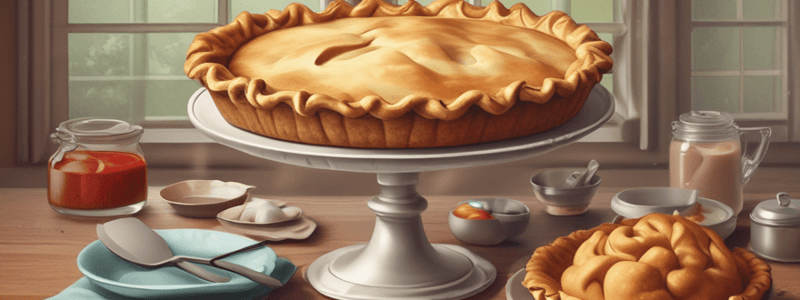Podcast
Questions and Answers
What is the primary difference between flaky and mealy pie dough?
What is the primary difference between flaky and mealy pie dough?
- The type of fat used
- The size of the fat particles (correct)
- The temperature of the dough
- The ratio of flour to fat
What happens to the flour when water is added to flaky pie dough?
What happens to the flour when water is added to flaky pie dough?
- It remains unaffected and does not absorb water
- It becomes separated from the fat particles
- It absorbs water and develops some gluten (correct)
- It becomes overworked and develops too much gluten
What is the characteristic of mealy pie dough that makes it suitable for bottom crusts?
What is the characteristic of mealy pie dough that makes it suitable for bottom crusts?
- Its flaky texture
- Its resistance to sogginess (correct)
- Its high gluten content
- Its tendency to absorb moisture
What is the result of blending flour and fat completely to make a smooth paste?
What is the result of blending flour and fat completely to make a smooth paste?
What is the term for a type of flaky pie dough with fat particles the size of walnuts?
What is the term for a type of flaky pie dough with fat particles the size of walnuts?
Why is less water needed in mealy pie dough?
Why is less water needed in mealy pie dough?
What is the characteristic of flaky pie dough that makes it suitable for top crusts?
What is the characteristic of flaky pie dough that makes it suitable for top crusts?
What is the result of the fat particles being left in large pieces in flaky pie dough?
What is the result of the fat particles being left in large pieces in flaky pie dough?
Flashcards are hidden until you start studying
Study Notes
Pie Dough Types
- There are two basic types of pie dough: Flaky and Mealy.
Flaky Pie Dough
- Fat is cut or rubbed into the flour until the particles of shortening are about the size of peas or hazelnuts.
- Flour is not completely blended with the fat, and the fat is left in pieces.
- When water is added, flour absorbs it and develops some gluten.
- When rolled out, the lumps of fat and moistened flour are flattened and become flakes of dough separated by layers of fat.
- Used for top crusts and sometimes for prebaked shells.
Mealy Pie Dough
- Fat is blended into the flour more thoroughly, until the mixture looks like coarse cornmeal.
- More complete coating of the flour with fat results in:
- Very short and tender crust.
- Less water needed in the mix.
- Baked dough is less likely to absorb moisture from the filling and become soggy.
- Used for bottom crusts, especially in baked fruit pies and soft or custard-type pies, because it resists sogginess.
- Can be blended together completely to make a smooth paste, resulting in a very short and tender crust when baked.
Studying That Suits You
Use AI to generate personalized quizzes and flashcards to suit your learning preferences.




